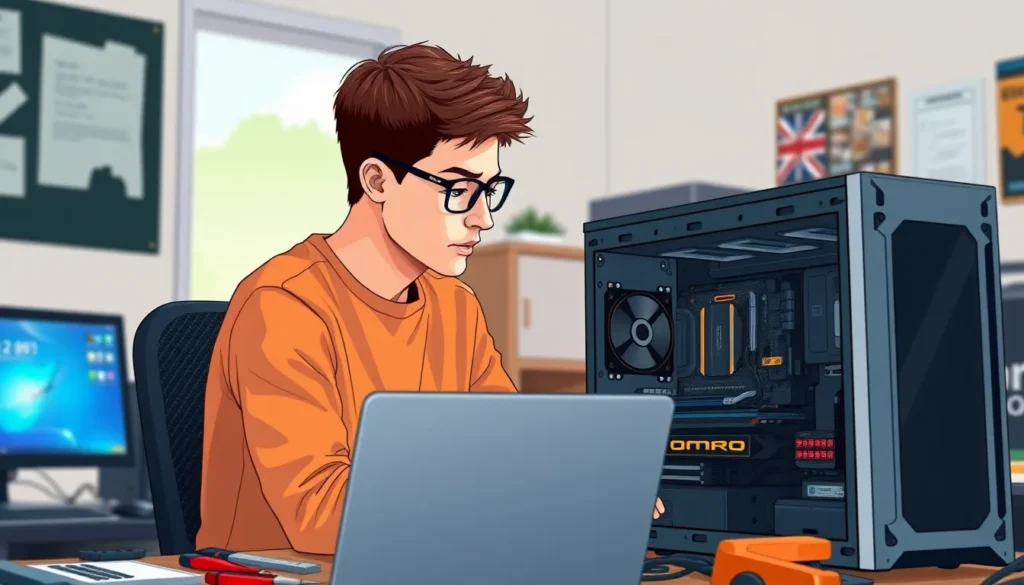
Building a gaming PC isn’t just a hobby; it’s a rite of passage for every gamer. It’s like assembling your own high-tech Lego set, but instead of a castle, you get a machine that can transport you to fantastical worlds. With the right tips, anyone can turn their dream rig into reality—no magic wands required.
Tips For Building A Gaming PC
Building a gaming PC requires knowledge of key components. Choosing the right elements ensures excellent performance and longevity.
CPU Selection Tips
Selecting the CPU forms the backbone of a gaming PC. Look for a processor with multiple cores and high clock speeds for optimal performance. Prioritize models from reputable brands like Intel and AMD, as they offer a range of options suitable for various budgets. Consider the purpose of the gaming PC; an enthusiast-level system needs higher specifications than a casual setup. Compatibility with the motherboard is crucial, so verify socket types before purchase.
GPU Importance in Gaming
The GPU is vital for rendering graphics and enhancing gaming experiences. It directly influences frame rates and overall visual quality. NVIDIA and AMD are two leading manufacturers offering diverse selections for different budgets. For modern gaming, aim for a GPU that meets at least 1080p gaming benchmarks. Keep in mind that higher-end GPUs can support 4K gaming; however, they may require significant investment. Ensure compatibility with the CPU to avoid bottlenecks in performance.
Motherboard Compatibility
Choosing the right motherboard connects all components of a gaming PC. It must support the CPU and GPU specifications while providing ample ports for additional devices. Look for features like USB-C and Wi-Fi capabilities to future-proof the build. Form factor matters too; ATX, micro-ATX, and mini-ITX sizes determine the case size. Always confirm the motherboard’s compatibility with RAM and storage types as well. A well-selected motherboard enhances overall performance and upgrade options.
Planning Your Budget

Establishing a budget is crucial for building a gaming PC. The financial plan determines component quality and overall performance.
Setting a Realistic Budget
Identify your financial limits before starting the build. Assess current market prices for essential parts like CPUs and GPUs. Establish a budget range between $800 to $2,000 for an effective gaming rig. Consider additional expenses like peripherals, software, and potential upgrades. Create an itemized list prioritizing key components. Set aside extra funds for unexpected costs to avoid overspending. Research discounts or bundled deals to maximize value.
Balancing Performance and Cost
Find the sweet spot between performance and cost for each component. Allocate a larger portion of the budget to the GPU, as it significantly impacts gaming experience. Choose a CPU that complements the GPU without breaking the bank. Prioritize features like RAM speed and storage type within your budget constraints. Evaluate reviews and benchmarks to ensure selected components offer the best value. Avoid overspending on non-essential features that don’t enhance performance.
Assembly Tips and Best Practices
Creating a suitable workspace maximizes efficiency during your gaming PC build. Clear a large, flat surface with good lighting. Gather all components and tools like screwdrivers, anti-static wristbands, and cable ties. Organize every part by type to avoid confusion and keep everything easily accessible.
Preparing Your Workspace
Choose a clutter-free environment for assembling the PC. Ensure you have sufficient room to lay out components and access them whenever needed. Consider using an anti-static mat to protect sensitive parts. Properly grounding yourself prevents potential damage from static electricity. Keep all tools and components organized, enabling smooth assembly without interruptions.
Step-by-Step Assembly Guide
Start by installing the CPU onto the motherboard. Align the CPU correctly and engage the locking mechanism gently. Next, insert RAM modules into the designated slots, ensuring a secure fit. Attach the motherboard to the case, aligning screw holes with standoffs. Afterward, install the power supply, connecting it to the motherboard and components. Place the GPU into its PCIe slot, securing it properly. Finally, manage cables for optimal airflow and connect all necessary storage drives. Following these steps carefully results in a well-assembled gaming rig that performs efficiently.
Cooling and Maintenance
Maintaining optimal cooling and routine upkeep maximizes performance and prolongs the lifespan of a gaming PC. Effective cooling prevents overheating.
Importance of Proper Cooling
Efficient cooling is crucial for maintaining system stability. Temperature control keeps components like the CPU and GPU running within safe limits. Excess heat can lead to thermal throttling, where performance diminishes due to heat buildup. A variety of cooling solutions exists, including air and liquid cooling systems. Fans should be strategically placed for optimal airflow. Even applying thermal paste correctly also enhances heat dissipation. Each component benefits from a well-ventilated case, allowing cooler air to enter while hot air exits, supporting overall longevity and efficiency.
Routine Maintenance Tips
Scheduled cleaning ensures components remain free of dust and debris. Dust filters can be installed in case openings to limit buildup. Regularly checking cable management improves airflow and prevents unnecessary obstruction. Monitoring temperatures and performance over time identifies potential issues early. Updating drivers and software contributes to smooth operation. Components might require reseating occasionally to maintain proper connections. Creating a maintenance schedule promotes continued performance, ensuring that the gaming rig functions optimally for an extended period.
Conclusion
Building a gaming PC is an exciting journey that empowers gamers to create a customized machine tailored to their needs. By carefully selecting components and following best practices for assembly and maintenance, anyone can achieve impressive performance and longevity from their rig.
Budgeting wisely and prioritizing essential parts like the GPU and CPU ensures that the final build meets gaming expectations without breaking the bank.
With the right approach to cooling and regular upkeep, the gaming experience can remain smooth and enjoyable for years to come. Embracing this process not only enhances gaming capabilities but also fosters a deeper connection to the technology behind it.


